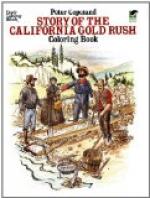All the California Indians are basket-makers, and their work is so well done and so beautiful that it is much prized. The Pomos of Lake and Mendocino counties make especially fine baskets for every purpose. Indeed, the Indian papoose, or baby, is cradled in a basket on his mother’s back; he drinks and eats from cup or bowl-shaped baskets, and the whole family sleep under a great wicker tent basket thatched with grass or tules. All Pomo baskets are woven on a frame of willow shoots, and in and out through this the mahala draws tough grasses or fine tree roots dyed in different colors, and after the pattern she chooses. Sometimes she works into the baskets the quail’s crest, small red or yellow feathers from the woodpecker, green from the head of the mallard duck, or beads. She also hangs wampum or bits of abalone shell on the finest ones. The storage baskets are four or five feet high to hold grain or acorns, and the baskets to fit the back and carry a load are like half a cone in shape, with straps to hold the burden in place. Their smaller berry baskets hold just a quart. Some are water-tight and are used to cook mush in. Fish-traps and long narrow basket-traps for quail are also made out of this willow-work.
On the Bidwell ranch is an old Indian “temescal,” or sweat-house. It is an underground hut, or cave dug out of a hillside, with a hole in the top for smoke to reach the air. The Indians used to build a big fire in this cave and then lie round it till dripping with sweat. A cold plunge into the creek near by finished the bath,—Turkish, we call it. Nowadays the Indians use this place for a meeting-room and for dances.
The older Indians still dance and rig out in all their finery of feathers and beads, though the young people are ashamed of their tribal customs and wish to be like the white folks. Some of their dances are named for a bird or animal, and the Indians must imitate by their dress and cries the animal chosen. In the bear dance the dancer crawls about the fire on all fours with a bear’s skin about him. He wears a chain of oak-balls round his neck, and as he shakes his head these rattle like a bear’s teeth snapping shut, while all the time he growls savagely. The feather-dancer, with a skirt and cap of eagles’ feathers, will whirl on his toes like a top for hours, while the other Indians sing and the master of the dance shakes a large rattle.
The California Indians are slowly passing away, and though all over the state there are still rancherias, the land that was once their very own will soon know them no more.




